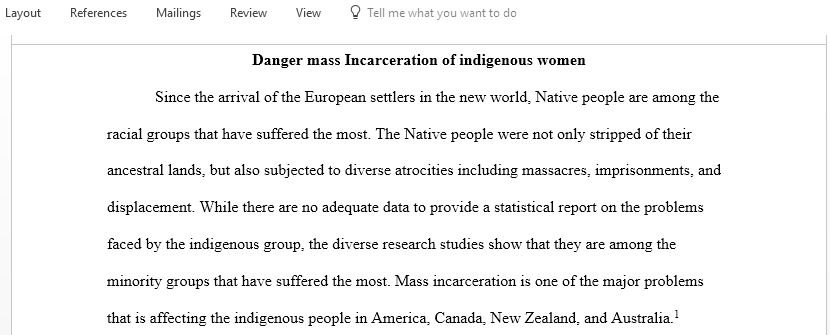Indigenous Women and Violence
Indigenous Women and Violence
• Using the articles attached as files, especially: “By Indigenous Incarceration: The Violence of Colonial Law and Justice” and “The Violent Legacies of the California Missions: Mapping the Origins of Native Women’s Mass Incarceration” to form and support your argument for why Indigenous women are largely overrepresented in federal correctional systems in the United States. Make sure to reference your argument within the context of U.S. settler colonialist history and explain how racism, sexism and colonialism continues to harm indigenous identity.
• Suggested consequences of the caceral system on indigenous women to reference: intergenerational trauma (associated with higher rates of violence and substance use traced to incarceration and poorer health).
• mental health disorders
• substance abuse
• Please make sure you do not summarize any of these articles, argue your position on why the disproportionate amount of incarcerated indigenous women is harmful, the long term implications, and how this system is a continuing result from history. Use the articles I attach as files to provide evidence in support of your thesis and points with both in text citations and a works cited page.
• Use the three articles I list below in your paper. In addition to the three articles which you can find attached as files, you must choose at least five academic/peer reviewed journal articles or books to also cite in your paper to further strengthen your points.
1. “By Indigenous Incarceration: The Violence of Colonial Law and Justice” by Cuneen
2. “The Violent Legacies of the California Missions: Mapping the Origins of Native Women’s Mass Incarceration” by Jackie Teran
3. “Applying an Indigenous and gender-based lens to the exploration of public health and human rights implications of COVID-19 in Canadian correctional facilities” Can J Public Health. 2020 Dec; 111(6): 971–974. Published online 2020 Oct 19. doi: 10.17269/s41997-020-00426-y
GUIDELINES
1. This is not a book review!
2. You can and should utilize sources from the class, but you should also use sources outside of those we have read
3. Choose your sources wisely; carefully evaluate their academic merit and reliability
4. Provide some analysis:
· Don’t just tell me what the other authors said about the topic;
· Tell me what you think about it (based on what you’ve read and what you know) and WHY, with supporting evidence
6. Use standard essay form: introductory paragraph, concluding paragraph, etc.
7. CITE your sources! There are several acceptable ways to cite sources; if you don’t know one, consult the Chicago Manual of Style (available in the library or at ). Make sure that you are citing consistently and properly based on the style you have chosen.
8. Use proper grammar and sentence structure. If you have doubts, consult Strunk and White’s Elements of Style, 4th edition. I will not correct grammar and if it is hard to understand your argument or seems like you did not make an effort, it will be reflected in your grade.
9. Spell check! There is no excuse for failing to take this simple step. Papers that have not been spell checked will be taken down one full letter grade (10 points on a 100 scale). Be warned!
10. Do not plagiarize. I check.
Answer preview for Indigenous Women and Violence
Access the full answer containing 2150 words by clicking the below purchase button.

